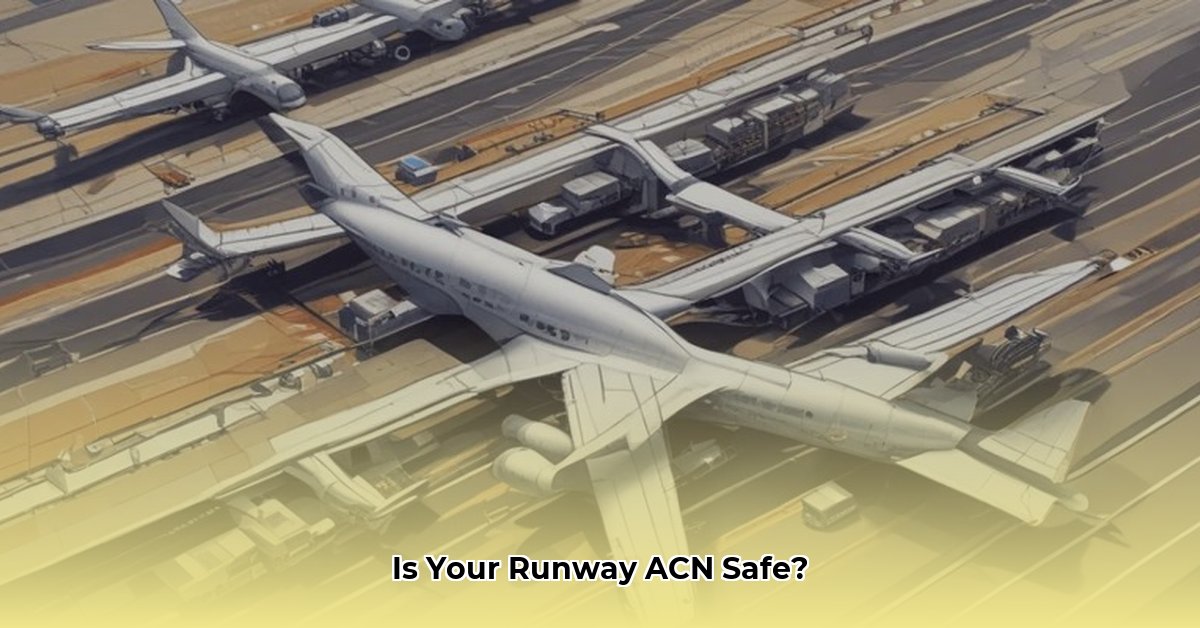Decoding the ACN: How It Keeps Airports Safe
Ensuring heavy aircraft don’t damage runways relies on a system involving the Aircraft Classification Number (ACN). This guide explains the ACN, its calculation, and its role in airport safety. We’ll also explore the Pavement Classification Number (PCN), and the newer ACR and PCR systems. Whether you’re a pilot, airport operator, or simply aviation-curious, this guide provides insights into how aircraft and pavements interact safely.
What is an Aircraft Classification Number (ACN)?
The ACN quantifies an aircraft’s relative impact on pavement. Think of it as a footprint indicating the pavement strength required to support the aircraft during landing, taxiing, and takeoff. This crucial data ensures safe and efficient airport operations.
Calculating the ACN
Determining the ACN involves evaluating several aircraft design and operational factors:
- Landing Gear Configuration: The number, spacing, and weight distribution of wheels influence pavement stress.
- Aircraft Weight: Maximum takeoff weight significantly affects pavement load.
- Tire Pressure: Higher pressure concentrates the load, increasing stress, while lower pressure distributes it over a larger area.
The calculation involves determining the Derived Single Wheel Load (DSWL), representing a single wheel’s impact. Doubling the DSWL accounts for aircraft dynamics during movement, yielding the ACN.
The Pavement’s Perspective: The Pavement Classification Number (PCN)
The PCN indicates a pavement section’s load-bearing capacity. This code, along with supplementary letters, describes its strength and suitability for aircraft. Key PCN components include:
- Numerical Value: Indicates load-bearing strength.
- Pavement Type: Specifies rigid (concrete) or flexible (asphalt).
- Subgrade Strength: Describes the underlying ground’s strength.
- Tire Pressure Limits: Defines acceptable tire pressures.
- Evaluation Method: Indicates assessment methods used.
The ACN and PCN Partnership
For unrestricted aircraft operation, its ACN must be less than or equal to the pavement’s PCN, within tire pressure limits. A higher ACN than PCN may lead to operational restrictions, such as payload limitations or even prevent aircraft usage.
The Future of Pavement Evaluation: ACR and PCR
Transitioning to ACR-PCR
The ACN-PCN system is being replaced by the Aircraft Classification Rating (ACR) and Pavement Classification Rating (PCR) methodology. ACR-PCR provides a more nuanced and accurate assessment, addressing limitations of the older system.
Why ACR-PCR?
The ACR-PCR system offers a more comprehensive approach by considering factors not fully captured by the ACN-PCN system, such as [specific examples of improved calculations and considerations]. This leads to more precise assessments of aircraft impact and pavement capacity, resulting in better safety margins and optimized pavement lifespan. This transition is part of the aviation industry’s continuous improvement efforts, ensuring that airport infrastructure can handle the increasing demands of air travel.
Transition Timeline
The transition to ACR-PCR began in July 2020, with full implementation expected by November 28, 2024. This transition enhances aviation safety and efficiency.
Locating ACN and PCN Information
The ACN is typically found in the aircraft’s characteristics manual, while the PCN for an airport is published in its Aeronautical Information Publication (AIP).
Real-World Application
A pilot with an aircraft having an ACN of 45 checks the destination airport’s AIP and finds the runway’s PCN is 50. Since the ACN is lower, the aircraft can operate without restrictions, assuming tire pressure is within AIP limits.
The Importance of ACN and PCN
Understanding ACN and PCN is crucial for all aviation stakeholders. Manufacturers consider ACN during design, airport planners use PCN for pavement design and maintenance. Even those with a general aviation interest benefit from understanding these concepts that ensure safe and efficient flight operations.
| PCN Code Letter | Meaning |
|---|---|
| A | Rigid Pavement (typically concrete) |
| B | Flexible Pavement (typically asphalt) |
| C | Composite and other types or requires further evaluation |
Airport Pavement Compatibility
Airport pavement compatibility, matching pavement strength to aircraft weight, is crucial for safety and efficiency. The ACN and PCN are key to this process.
The ACN measures the “stress” an aircraft exerts on pavement, considering weight, landing gear, and tire pressure. The PCN is the pavement’s strength rating, including details about its structure and composition.
Matching ACN to PCN prevents runway failures, increases payload and fuel efficiency, and extends pavement lifespan.
Pilots compare aircraft ACN to airport PCN before landing. If ACN is less than or equal to PCN (and tire pressures are within limits), landing is generally safe. A higher ACN may necessitate weight restrictions or operational adjustments.
Calculating ACN: A Detailed Look
Calculating the ACN involves several key factors:
- Aircraft Weight: The total weight significantly impacts the ACN.
- Landing Gear Configuration: Wheel number, spacing, and configuration influence weight distribution.
- Tire Pressure: Tire pressure affects the load concentration on the runway.
Ongoing research continually refines ACN calculations, incorporating new materials and modeling techniques.
While ICAO Doc 9157 provides detailed guidance, determining PCN often involves assessing pavement composition, thickness, and subgrade strength. Variations in assessment methods exist among organizations.
For safe operation, an aircraft’s ACN should not exceed the runway’s PCN. Exceeding the PCN might require weight reductions or other operational adjustments. Jeppesen charts, airfield manuals, apps, and ICAO Doc 9157 provide ACN and PCN information.
The Interplay of ACN and PCN
ACN quantifies an aircraft’s impact, or “footprint,” on the pavement during landing. This considers weight, landing gear type, and tire pressure. The PCN represents the pavement’s strength.
Safe operations require the PCN to be equal to or greater than the ACN. A higher ACN than PCN could lead to runway damage or operational restrictions.
The ACN-PCN system is transitioning to ACR-PCR, offering a more detailed and accurate evaluation, accommodating modern aviation complexities. This new methodology enhances safety and efficiency by incorporating factors previously not fully considered.
Understanding ACN, PCN, ACR, and PCR is crucial for pilots, airport operators, and the broader aviation industry. The transition to ACR-PCR necessitates staying informed and adapting to the ongoing evolution of aviation safety standards.
| Feature | ACN (Aircraft Classification Number) | PCN (Pavement Classification Number) |
|---|---|---|
| Represents | Aircraft’s impact on pavement | Pavement’s load-bearing capacity |
| Found in | Aircraft’s characteristics manual | Airport’s Aeronautical Information Publication (AIP) |
| Factors | Weight, landing gear configuration, tire pressure | Pavement type, subgrade strength, tire pressure limits, evaluation method |
| Higher Value Means | Greater impact on pavement | Stronger pavement |
| Future | Being replaced by ACR (Aircraft Classification Rating) | Being replaced by PCR (Pavement Classification Rating) |
Our understanding of these concepts continually evolves through research and industry advancements.
ACN-PCN to ACR-PCR: A Paradigm Shift
The transition from ACN-PCN to ACR-PCR represents a significant upgrade in evaluating aircraft-runway interactions. The older system, while functional, had limitations in accurately predicting real-world scenarios and incorporating technological advancements.
ACR-PCR offers a more sophisticated and detailed assessment, considering factors like tire pressure and landing gear configuration. This enhanced precision improves efficiency and safety. It also allows for better pavement lifespan predictions, optimizing maintenance planning.
Key differences between the systems:
| Feature | ACN/PCN (Old System) | ACR/PCR (New System) |
|---|---|---|
| Aircraft Load | Less precise | More precise |
| Pavement Strength | Less precise, relied on airport input | More precise, considers actual conditions |
| Flexibility | Limited | More adaptable to new technology |
| Data | Needs updating | Needs updating |
The transition requires significant adjustments for airports and operators, including runway re-evaluation, data updates, procedural changes, and training. The deadline for new classifications is November 28, 2024. While concurrent use of both systems is anticipated, early adoption is suggested for smoother integration and proactive issue identification. Although ongoing research may lead to further refinements, ACR-PCR’s core principles are well-established, providing a robust framework for enhancing airport safety and operational efficiency. The transition may present initial challenges, but the long-term benefits for a more sustainable aviation industry are expected to be substantial.
- What Types Of Jobs Does Wind Energy Create? - November 23, 2025
- Residential Wind Energy: Powering Homes with Small Turbines - November 21, 2025
- How Did Charles F. Brush Discover Wind Energy Tech? - November 19, 2025
















